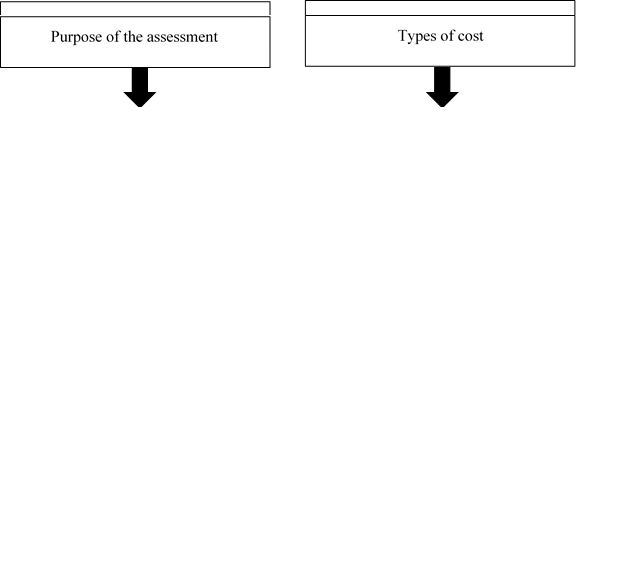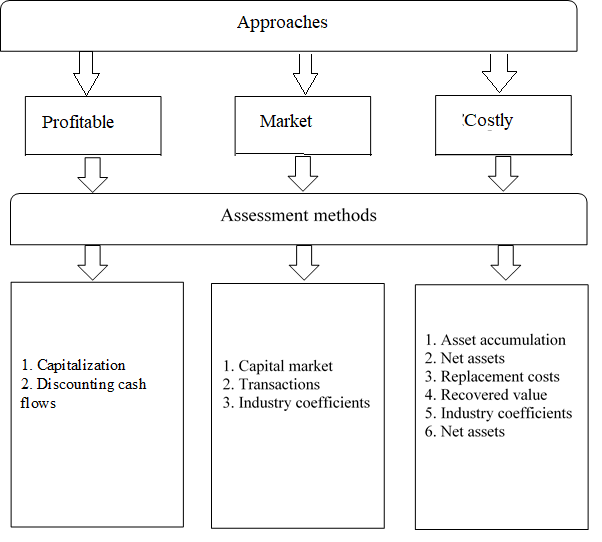Abstract
- Introduction
- 1. The purpose and objectives of the study
- 2. Theoretical foundations and practical significance of enterprise valuation
- 2. Analysis of the financial condition of the company and the assessment of its value
- 4. Methodical recommendations for improving the assessment of the market value of the company and improving its financial condition
- Conclusion
- References
Introduction
With the development of a market economy, it became possible to invest in a business, buy and sell it, i.e. business has become a commodity and object of evaluation. Valuation is necessary when corporatization, reorganization, development of enterprises, the use of mortgage lending, participation in the stock market activities. Independent assessment is an important management tool, increasing the value of an enterprise is one of the indicators of the growth of incomes of its owners and, accordingly, the periodic determination of the value of a business can be used to assess the effectiveness of enterprise management.
1. The purpose and objectives of the study
The purpose of the study is to assess the market value of the enterprise.
Objectives of the study:
– to study the theoretical basis for assessing the market value of the enterprise;
– to justify the practical significance of the valuation of the enterprise;
– explore the differences between asset value and market value;
– to analyze the financial condition of the company.
Subject of research – methods for assessing market value.
Object of study – the market value of the enterprise.
2. Theoretical foundations and practical significance of enterprise valuation
The valuation of the enterprise (business) is the calculation and justification of the value of the enterprise, taking into account the factors affecting it at a particular point in time in a particular market. [1]
The calculation of the market value in the modern economy is necessary for the following reasons [2]:
– assessment of market value allows the seller or buyer to “put” the goods at the most realistic price, as the market value takes into account not only and not so much individual costs and expectations, but the situation in the market as a whole, market expectations, general economic development trends, assessment of this object market side;– knowledge of the value of the market value allows the owner of the object to optimize the production process, if necessary by adopting a number of measures aimed at increasing it;
– periodic market valuation helps to improve management efficiency and, therefore, prevent bankruptcy;
– the buyer-investor valuation helps to make the right investment decision.
Depending on the purpose of the assessment, the number and selection of factors taken into account, the appraiser calculates various types of value: market, investment, balance, insurance, taxable, liquidation (img. 1). [3]

Image 1 – Relationship between the purpose of the valuation and the types of value used for valuation
(animation: 5 frames, infinite number of repetitions, 84 kilobytes)
To determine the market or other type of value, appraisers use special techniques and methods of calculation, which are called valuation methods. Depending on the cost factors, which are the main variables in the algorithms, the evaluation methods are divided into the methods of the income, comparative and cost approach (img 2). Each approach allows you to "catch" certain cost factors.

Image 2 – Methods of estimating the value of the enterprise [4]
Thus, the income approach is the determination of the present value of future income, which is expected to bring about the use and possible further sale of property.
The comparative approach is especially useful when there is an active market for comparable properties. Comparative approach is based on the principle of substitution.
The cost approach is based on the principle of substitution, the principle of the best and most efficient use, balance, economic size and economic division.
In general, all three approaches are interconnected. In a perfect market, all three approaches should lead to the same value of value. However, most markets are imperfect, supply and demand are not in balance. [5]
3. Analysis of the financial condition of the company and the assessment of its value
The main stage of business valuation is financial analysis. It provides the necessary number of parameters for an objective and accurate verification of the financial condition of the company, its profit and loss, value, changes in assets and liabilities [6]. The analysis of the financial condition of the company showed that the company has good results only for some indicators, and in general the company is financially unstable.
The company has the potential for development, but will succeed only if it can improve its financial system.
To assess the value of the company was chosen income approach, which includes the method of discounting cash flows. Calculated by this method, the cost amounted to 699937.55 thousand. An increase in the value of an enterprise is inherent in the improvement of its financial condition, which in turn is possible due to [7]:
1) reduction of receivables;
2) increase the rate of turnover of working capital;
3) increase balance sheet liquidity;
4) improve profitability.
To reduce the receivables, the company should as soon as possible optimize the conditions of the transactions.
From the acceleration of the turnover of working capital depends not only the improvement of the structure of the balance sheet of the enterprise, but also the ability of the enterprise to have free cash at the expense of higher profits and lower costs.
To improve the liquidity of the enterprise, it is necessary to take the following measures [8]:
1. A diversification of production, that is, the distribution of assets across various activities, is considered a reliable method of improving financial condition.
2. A significant factor influencing the improvement of the financial position of an enterprise is the repayment of the receivables of the enterprise.
3. As additional sources of financing, non-traditional methods of updating the material base and accelerated modernization of fixed assets can be singled out, one of which is leasing.
4. Another factor of financial recovery is the improvement of contractual discipline.
The source of growth in the profitability index can be the introduction of innovations that allow producing a new type of goods with better quality, developing new product sales markets, and introducing organizational and managerial innovations.
3. Methodical recommendations for improving the assessment of the market value of the company and improving its financial condition
Accurately determine the value of a business is possible only with the involvement of relevant companies that specialize in valuation, possessing relevant knowledge, experience and specialists.
In this regard, in modern practice, enterprise managers can use express methods for estimating the value of an enterprise. One of such methods is the calculation of the company's value based on the financial EBITDA [9].
The company's EBITDA was CU 132764.00 thousand, the cost of this enterprise on the basis of express-valuation was CU 663820.00 thousand. The deviation of the value of the enterprise value, calculated by the express method, from the value of the enterprise, calculated by the income approach of 5%, which can be considered the error of the rapid assessment. The results obtained indicate a high reliability of the applied method.
Express assessment allows you to accurately calculate the value of the company in a very short time in the presence of the necessary financial information [10].
Conclusion
Today, corporate finance transactions play an important role, both for the company and for its management, management and shareholders. Effective management of such transactions leads to the prosperity and dynamic development of the company.
One of the important components of corporate finance is the valuation of the company. The company's value shows its success in the market, prospects for future development and the feasibility of investing in its assets. Thus, the ability to correctly evaluate a company allows determining its fair value and whether it is worth investing in it. Also, the valuation is carried out not only by potential investors, but also by the company itself, in order to identify how effectively the management manages the cost, and what factors influenced the increase or decrease in the company's value.
This master's work is not completed yet. Final completion: June 2019. The full text of the work and materials on the topic can be obtained from the author or his head after this date.
References
- Грязнова А.Г., Федотова М.А, Оценка бизнеса. Учебник / Под ред. А.Г. Грязновой, М.А. Федотовой. 2-е издание, перераб. и доп. – Москва: Финансы и статистика, 2009. – 736 с.
- Оценка стоимости предприятия (бизнеса): Учебник / Н.Ф. Чеботарев. – М.: Издательско-торговая корпорация
Дашков и К
, 2009. – 256 с.. - Щербаков В.А., Щербакова Н.А. Оценка стоимости предприятия (бизнеса) / В.А. Щербаков, Н.А. Щербакова. 3-е изд. – М.: 2008. – 288 с.
- Шпилевская Е.В., Медведева О.В. Оценка стоимости предприя¬тия (бизнеса). Издательство
Феникс
, 2010. – 352 с. - Джеймс Р. Хитчнер. Три подхода к оценке стоимости бизнеса. – М.: Маросейка, 2008. – 306 c.
- Ефимова О.В. Финансовый анализ: современный инструментарий для принятия экономических решений: Учебник / О.В. Ефимова. - М.: Омега-Л, 2013. – 349 c.
- Урманбекова И. Ф. Улучшение финансового состояния предприятия // Молодой ученый. – 2017. – №17. – С. 391-394.
- Танашева О.Г. Мониторинг в системе управления расчетами с дебиторами / О.Г. Танашева, А.В. Урванцева // Аудиторские ведомости. – 2010. – №12. – С.32-39.
- Шибилева О. В., Пониматкина Е. Оценка стоимости компании на основе показателя EBITDA // Молодой ученый. – 2012. – №2. – С. 151–153.
- Компания сквозь призму EBITDA (интервью с Д. Басыровой, начальником отдела консолидации по МСФО компании
ЕвроХим
) / О. Сизова // Консультант. – 2007. – №21(11).
